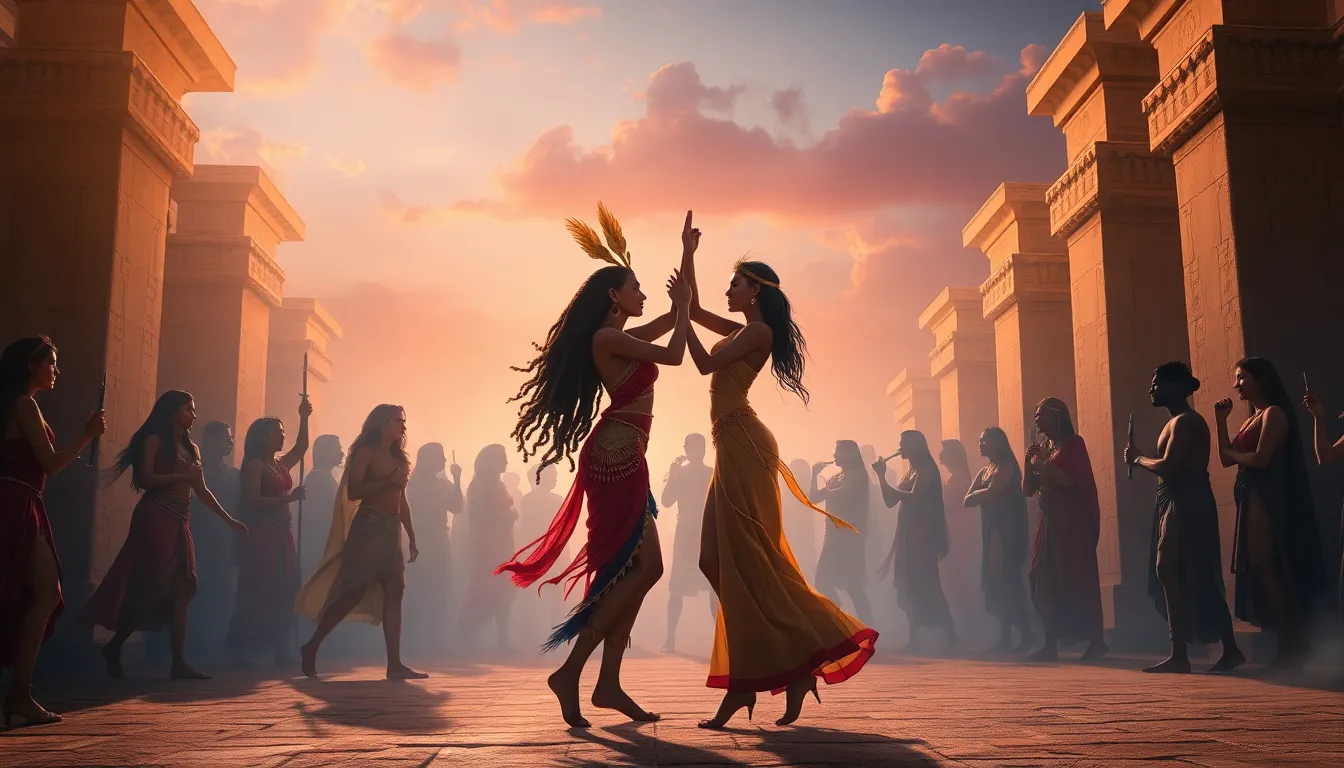The Story of the First Dance: Hathor and the Origins of Celebration
I. Introduction
Dance has been an integral part of human culture since the dawn of civilization. It serves as a form of expression, communication, and celebration, transcending borders and languages. In ancient Egypt, one of the most revered figures associated with dance and celebration was the goddess Hathor, who embodied joy, music, and festivity.
This article delves into the significance of Hathor in the context of celebration and explores the origins of dance as a form of communal joy. By examining her role in ancient rituals and the evolution of dance through the ages, we aim to highlight the enduring legacy of dance in human culture.
II. Hathor: The Goddess of Joy and Dance
Hathor was one of the most important deities in ancient Egyptian mythology. Known as the goddess of joy, love, and motherhood, she was often depicted as a cow or a woman with cow’s horns, symbolizing fertility and nourishment.
Some key attributes and symbols associated with Hathor include:
- The sistrum, a musical instrument that represented her connection to music and dance.
- Cow horns and the sun disk, symbolizing her nurturing nature.
- Lotus flowers, representing rebirth and beauty.
Hathor played a crucial role in music, dance, and festivity, often being invoked during celebrations and significant life events such as births, marriages, and harvests. Her presence was believed to bless these occasions with joy and abundance.
III. The Concept of Celebration in Ancient Cultures
Celebration is a universal human experience, often marked by rituals that bring communities together. Across civilizations, celebrations serve to commemorate important events, honor deities, and strengthen social bonds.
Dance has been a vital part of these celebrations, acting as a universal language that transcends cultural differences. Some notable examples of ancient celebrations that incorporated dance include:
- The ancient Greek Dionysia, a festival honoring the god Dionysus through dramatic performances and dance.
- The Roman Saturnalia, a festival of feasting, dancing, and merrymaking.
- The Mayan ceremonies that included dance as a way to honor their gods and seek blessings.
In each of these cultures, dance was not just entertainment but a significant expression of communal joy and spirituality.
IV. The First Dance: Myth and Symbolism
According to ancient Egyptian mythology, the first dance was attributed to Hathor, who is said to have performed it to celebrate the creation of the world. This myth encapsulates the idea that dance is a divine gift, a means of connecting the earthly realm with the divine.
Dance held symbolic meanings in ancient rituals, serving as a medium for:
- Expressing gratitude to the gods.
- Marking life’s significant transitions.
- Fostering a sense of community and belonging.
The transformative power of dance was evident in its ability to bond communities, making individuals feel part of something larger than themselves.
V. Rituals and Ceremonies in Honor of Hathor
Ancient Egyptian festivals dedicated to Hathor were vibrant occasions filled with music, dance, and joy. One of the most notable celebrations was the Feast of Hathor, held annually at her temple in Dendera. This festival included:
- Processions with music and dance.
- Offerings and sacrifices to honor the goddess.
- Community feasting and merriment.
Music and dance were integral to these ceremonies, allowing participants to express their devotion and joy. These rituals had a profound impact on social cohesion, fostering a shared cultural identity that bound the community together.
VI. The Evolution of Dance as a Celebration
The concept of dance has evolved significantly over the ages. From ancient rituals honoring deities to modern celebrations of life events, dance has remained a vital form of expression. The influence of Hathor’s legacy is evident in various celebratory dances today, which often carry elements of joy and community bonding.
Cross-cultural exchanges and adaptations of dance rituals have also enriched the global tapestry of dance. Today, we can see the echoes of ancient practices in:
- Contemporary folk dances that celebrate cultural heritage.
- Modern social dances that bring people together in celebration.
- Global dance festivals that showcase a myriad of traditions.
This evolution highlights the adaptability of dance as a celebration, allowing it to resonate with diverse cultures and communities.
VII. The Psychological and Social Benefits of Dance
Dance is not only an art form but also a powerful tool for psychological well-being and social connection. Studies have shown that dance can:
- Reduce stress and anxiety, promoting mental health.
- Enhance mood and increase feelings of happiness.
- Foster social bonds and community engagement.
The psychological effects of dance contribute to its relevance in contemporary celebrations, where it serves as a means of uniting individuals and creating a sense of belonging.
VIII. Conclusion
Hathor’s influence on the concept of celebration and dance is profound, reflecting her role as a goddess of joy and festivity. The enduring legacy of dance in human culture showcases its importance in fostering community, expressing joy, and celebrating life’s milestones.
As we reflect on the power of dance, we are reminded of its ability to bring people together in celebration. Embracing dance in our modern lives can enhance our connections with one another, enriching our shared experiences and cultural identities.




